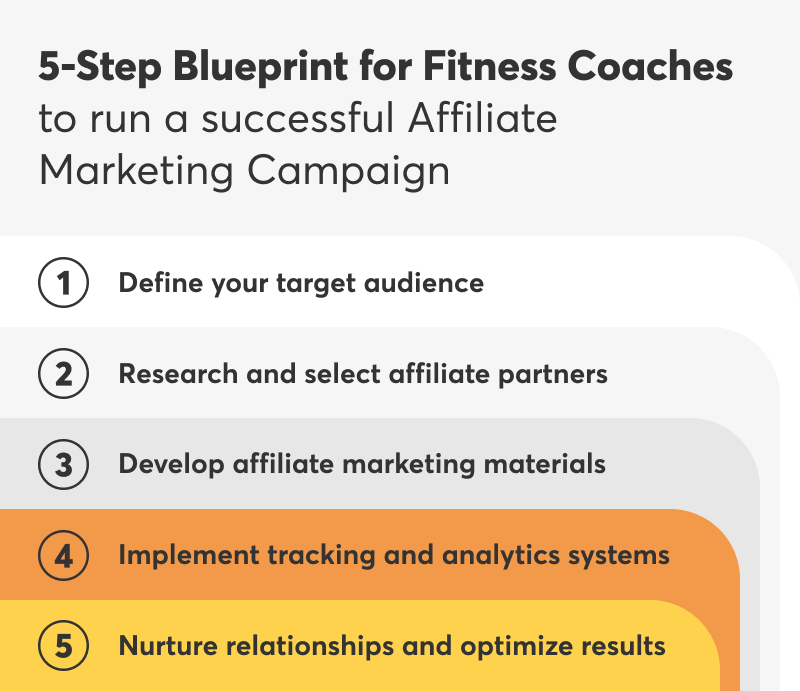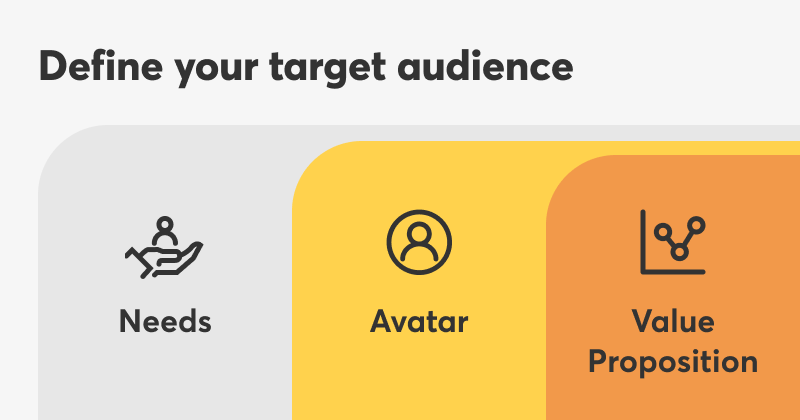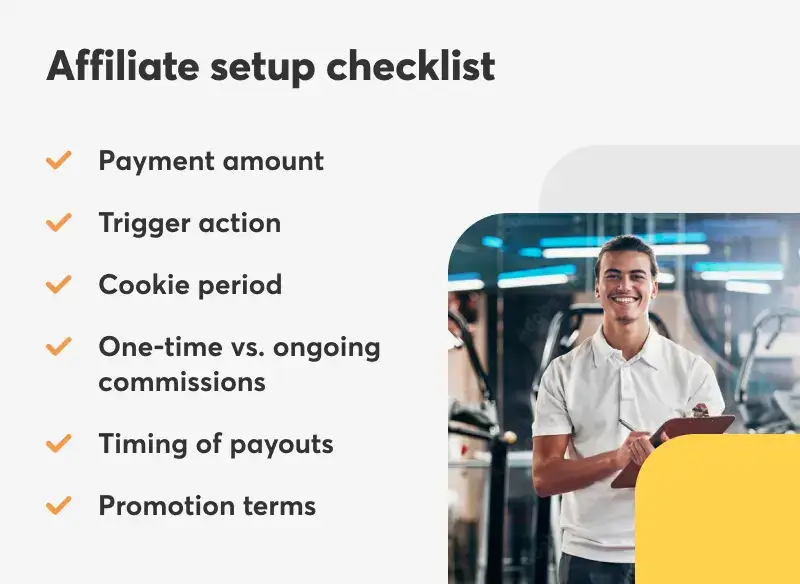Table of Contents
What do Lululemon, Fitbit, and TRX have in common? They all use affiliate marketing to promote their fitness brands.
If household names in fitness use affiliate marketing, imagine what this simple lead generation strategy can do for your fitness coaching brand.
With a market value of over $17 billion and 16% of online orders coming from affiliate links, affiliate marketing can be an effective way to get fitness influencers to attract those new leads for you.
If you want to give affiliate marketing a try to grow your fitness brand, we have a spot-on 5-step blueprint in place for you:
Table of contents

How Does Affiliate Marketing Work?
Affiliate marketing takes place when you recruit partners to promote your products or services for you in exchange for a share of the sale.
Partners, or affiliates will be promoting your services to their audience through social media, email, community, or website through a unique link. Anyone buying through that link will be assigned to that affiliate who will get a commission.
LearnWorlds has a superb built-in feature to manage & track affiliate programs for online courses. You can use LearnWorlds to sell your fitness courses and your coaching services.
Your professional looking Academy in a few clicks
Start FREE TrialKeep reading as we dig into each of the steps and get started on your affiliate marketing campaign for lead generation.
Step 1: Define Your Target Audience
Sure, you want to make a positive impact on the health of as many people as possible, but your particular brand of fitness coaching might not be the perfect match for everyone.
Maybe you’re an expert at prenatal workouts for high-risk mothers, or perhaps you’re using your medical knowledge from your previous career to develop fitness programs for people with arthritis.
Some fitness coaches hone in on busy professionals who don’t have time for the gym, older adults who need modified workouts, or athletes who want to optimize their performance.
How you market to your target audience depends on who you’re targeting. The Silver Sneakers crew isn’t going to respond to the same type of marketing as young parents.
Your lead generation efforts will be more effective if you narrow your focus to a specific niche. That includes your affiliate marketing campaigns.

Understanding the needs and preferences of your audience
Start with customer targeting, i.e. identifying your target audience.
What type of person does your style of fitness help? Think about the following when determining the needs and preferences of your audience:
Creating an ideal customer profile (avatar)
Once you’ve identified your target audience, you can build a customer profile or an avatar representing your ideal client. This takes market research to determine how your audience spends their time and what their pain points are.
For example, if you’re targeting new moms who work full-time, their pain points might include not having time for regular workouts or feeling too tired at the end of the day. They want quick and effective workouts they can do anywhere and may even be looking for workouts they can do with their kids.
Crafting a compelling value proposition
Your value proposition is a brief statement explaining why your product is the best for your target audience. It should explain why they should choose you instead of the millions of other fitness professionals out there, speak to their pain points, and show how your online fitness coaching product will solve them. But instead of focusing so much on your product, concentrate on the outcomes.
Step 2: Research and Select Affiliate Partners
Your affiliate partners are the heart of your affiliate campaign. They’re the ones who promote your online fitness program to their established audiences.
The best affiliate partners already have a following and are known in the fitness niche or with your target audience.
Generating a list of prospective affiliate partners
Start by researching your niche on social media. You might concentrate your efforts on fitness, wellness, and health influencers or hone in on other audience characteristics.
For example, those who are focusing on workouts for college athletes might target athletes, coaches, or recruiters, while those who are offering fitness courses for moms, may be best served by looking at the top mom influencers.
Look for people with lots of valuable content. Consider the consistency of their posts, how many followers they have, and how their brand complements yours.
It isn’t just about follower count, although a larger following gets your brand in front of more people.
An influencer with millions of followers might not convert many of their fans into buyers of your fitness products. On the other hand, a smaller creator with a rabid following could send you lots of hot leads.
You want affiliate partners with highly engaged followers. Look for lots of interaction in their posts.
⚠ If someone has 500,000 followers but only a few likes or comments, they don’t have much engagement. Even if they post about your brand, they likely won’t generate much traffic.
Researching influencers’ credibility and reputation
We’ve all seen influencers with millions of followers make one bad — and very public — mistake that destroyed their personal brand instantly.
Others have a track record of being controversial, making out-of-pocket comments, or using shady tactics to monetize their platforms.
You want to avoid those types of affiliate partners to maintain your public image. Dig a little deeper into each affiliate you’re considering!
Credibility is a huge factor. Does the potential affiliate have a degree or certification in the fitness world, or are they a self-proclaimed fitness expert with no real knowledge offering borderline-risky wellness advice? Have they had PR issues in the past?
When you choose an affiliate, they become a face for your brand even though they aren’t an employee. Make sure the affiliate partners you choose reflect your core values and will represent you well.
Negotiating mutually beneficial partnerships
Now you’re ready to make a deal with your target affiliate partners. Your goal is to grow a profitable fitness business, but you also need to sweeten the deal for your affiliates to get them excited about doing business with you.
Your affiliates will be more motivated to promote your product if they can make good money with it.
Affiliate commission rates typically range between 5% and 30%, but you can set whatever rates you want. You can also set a flat rate for a specific action.
If you want to be competitive, look at the details of affiliate programs for similar products.

Consider adding the following details to your affiliate marketing campaign:
Payment amount: Specify the percentage or flat rate for a specific action.
Trigger action: It’s common to only pay affiliates if someone makes a purchase using their link, but some programs payout for a lead or another action. Define what consumers have to do to earn money for your affiliates.
Cookie period: For many affiliate programs, a purchase counts even if the person doesn’t make a purchase immediately. Say someone clicks a link and doesn’t purchase immediately, but they come back 2 days later and purchase your fitness product. Does the affiliate make a commission? Specify the length of the cookie period to eliminate any confusion about these types of delayed purchases.
One-time vs. ongoing commissions: Depending on the setup of your online program, your customers might make recurring purchases. For example, you might offer a one-time fitness class or a recurring monthly subscription. If you offer a recurring service, decide whether your affiliates will receive ongoing commissions or only for the first month.
Timing of payouts: Specify when affiliates will receive payments, such as once per month. You might also specify a minimum payout amount. If your minimum payout is $50, you might roll over commissions from month to month until an affiliate reaches that threshold.
Promotion terms: Decide how affiliates are allowed to promote their links or recruit customers. For example, you might not allow them to earn commissions on their own purchases or purchases made by family members. Maybe you won’t allow them to use paid searches to promote their links, or you might require them to disclose that they’re an affiliate.
Step 3: Develop Affiliate Marketing Materials
Your affiliates need high-quality promotional materials to make their promotional efforts successful. Create persuasive content that hooks your target audience and convinces them to try your services without being too salesy. This requires a deep knowledge of how your target audience thinks and what appeals to them.
Next, you need to turn that content into visually attractive, attention-grabbing promotional materials, including:
These and more collateral can be used to promote your program. The materials should match your branding to help with brand recognition.
Make these materials easily accessible to your affiliates. For example, you could create a QR code to share with affiliates that links out to your brand’s collateral and affiliate materials. Create an affiliate hub with promotional materials, education on your products, and tutorials on how to be a successful affiliate. Putting time into supporting your affiliates can improve their outcomes, which ultimately benefits everyone.
Step 4: Implement Tracking and Analytics Systems
Choosing a robust affiliate marketing platform makes it easy to measure affiliate activity.
With LearnWorlds, you have full control over the commission rate you offer, the referral cookie expiration period, and the maturity period for the commissions.
Your dashboard lets you easily check metrics, such as sales, referred customers, and more. You can also get detailed reporting to help you evaluate the success of the program and shape it for future growth.
Your professional looking Academy in a few clicks
Start FREE TrialA successful affiliate marketing campaign needs accurate tracking, so you can see which affiliates are sending you traffic.
This is how you calculate the commissions, and you can use the information to determine the success and effectiveness of the campaign.
Are your affiliates driving traffic to your site? Are those clicks converting into purchases?
You can use that data to make decisions about your affiliate program. It can help you adjust your affiliate percentages, trigger actions, and the types of promotions you run.
When you make changes to your campaign, monitor the metrics to determine their impact and whether they were effective.
Step 5: Nurture Relationships and Optimize Results
Once you get your affiliate marketing campaign up and running, you can breathe a sigh of relief. But your work isn’t done just yet.
Affiliate marketing can help the leads roll in, even when you’re not actively pursuing them. However, you still need to nurture your relationships with your affiliate partners and continue improving the program to make it as effective as possible.
Communicating clearly with your affiliates helps keep excitement high for the program.
Send them regular updates and get to know them, especially if you have a small affiliate team. Offering regular deals or new promotional options can also help keep interest high and support ongoing collaboration.
Offering ongoing support
Being easily accessible to affiliates can reduce frustration. Offer clear affiliate support channels through phone, email, text, or chat. Sending regular emails with promotion ideas, educational materials, and other forms of support can also help.
Optimizing campaigns
Remember those analytics you set up?
They can come in handy to continue optimizing your campaigns. Look at where most of your traffic comes from and what types of special promotions work best. Testing different promotional materials and special offers can help you optimize your campaigns.
You can also get feedback from your affiliates.
This feedback can let you know whether you’re on the right track or if there are ways you can improve.
Generate Leads for Your Fitness Brand With Affiliate Marketing
Moving into the affiliate marketing industry can be an effective way to leverage your fitness knowledge and generate new leads.
Start by narrowing your focus to the specific type of fitness fan you want to target. This helps you tailor your affiliate marketing plan to reach those people effectively.
Next up, you need to find ideal affiliate partners to make your program a success and develop high-quality, appealing materials.
This leads into creating a tracking system that measures analytics to track the success of your affiliates.
Nurturing those relationships helps you grow your affiliate program and increase the number of leads you generate.
Ready to start your affiliate marketing journey?
LearnWorlds’ all-in-one course platform is ideal for fitness coaches and comes with built-in affiliate management features. Get started with your 30-day free trial and experience first-hand the transformative impact it can have on your affiliate marketing efforts!
Your professional looking Academy in a few clicks
Start FREE TrialNick Malekos is a Senior Digital Marketer in LearnWorlds. He is a results based and well-rounded Digital Marketer with years of experience in the education industry, writer and digital literacy trainer.




